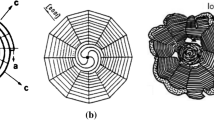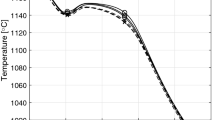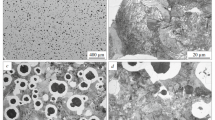Abstract
Growth of graphite during solidification and high-temperature solid-state transformation has been investigated in samples cut out from a thin-wall casting which solidified partly in the stable (iron–graphite) and partly in the metastable (iron–cementite) systems. Transmission electron microscopy has been used to characterize graphite nodules in as-cast state and in samples having been fully graphitized at various temperatures in the austenite field. Nodules in the as-cast material show a twofold structure characterized by an inner zone where graphite is disoriented and an outer zone where it is well crystallized. In heat-treated samples, graphite nodules consist of well-crystallized sectors radiating from the nucleus. These observations suggest that the disoriented zone appears because of mechanical deformation when the liquid contracts during its solidification in the metastable system. During heat-treatment, the graphite in this zone recrystallizes. In turn, it can be concluded that nodular graphite growth mechanism is the same during solidification and solid-state transformation.







Similar content being viewed by others
References
B. Lux: AFS Cast Metals Res. J., 1972, vol. 8, pp. 25-39.
I Minkoff, B Lux (1975) The Metallurgy of Cast Iron, B Lux, I Minkoff, F Mollard (Eds), Georgi Publishing Company, St. Saphorin, 1975, pp. 473-491.
D.D. Double, A. Hellawell: Acta Metal., 1974, vol. 22, pp. 481-487.
M. Hillert, Y. Lindblom: J. Iron Steel Inst., 1954, vol. 148, pp. 388-390.
B. Miao, D.O. Northwood, W. Bian, K. Fang, M. H. Fan: J. Mater. Sci., 1994, vol. 29, pp. 225-261.
I. Minkoff: The Physical Metallurgy of Cast Iron, 1st ed., Wiley, Chichester, 1983, pp 102-133.
G. Faivre: Adv. Mater. Res., (1997), vol. 4-5, pp. 17-30.
J. Qing, V.L. Richards, D.C. Van Aken: Carbon, 2017, vol. 116, pp. 456-469.
J. Lacaze, K. Theuwissen, L. Laffont, M. Véron: IOP Conf. Series: Materials Science and Engineering, 2016, vol. 117, pp. 012024.
PhD dissertation, Missouri S&T, 2016. http://scholarsmine.mst.edu/doctoral_dissertations/2489/, accessed November 26, 2016.
S. Amini, R. Abbaschian: Carbon, 2013, vol. 51, pp. 110-123.
D.M. Stefanescu, G. Alonso, P. Larranaga, E. De la Fuente, R. Suarez: Acta Mater., 2016, vol. 107, pp. 102-126.
D.D. Double, A. Hellawell: Acta Metal. Mater., 1995, vol. 43, pp. 2435-2442.
K. Theuwissen, M.C. Lafont, L. Laffont, B. Viguier, J. Lacaze: Trans. Indian Inst. Met., 2012, vol. 65, pp. 627–631.
K. Theuwissen, J. Lacaze, M. Veron, L. Laffont: Materials Characterization, 2014, vol.95, pp. 187-191.
K. Theuwissen, J. Lacaze, L. Laffont: Carbon, (2016), vol. 96, pp. 1120-1128.
J.P. Monchoux, C. Verdu, G. Thollet, R. Fougères, A. Reynaud: Acta Mater., 2001, vol. 49 pp. 4355-4362.
D. Li, R. Tan, J. Gao, B. Wei, Z. Fan, Q. Huang, K. He: Carbon, 2017, vol. 111, pp. 428-438.
R. Ghergu, L. Magnusson Åberg, J. Lacaze: Materials Science Forum, 2014, vol. 790-791 pp. 435-440.
J. Lacaze, J. Bourdie, M.J. Castro-Roman: Acta Mater., 2017, vol. 134, pp. 230-235.
J. Fargues, J.C. Margerie: Fonderie, 1979, vol. 390, pp. 205-221.
G.S. Jayaraman, R.D. Maier, J.F. Wallace: AFS Trans., 1979, vol. 87, pp. 299.
K. He, A. Brown, R. Brydson, D. Edmonds: J. Mater. Sci., 2006, vol.16, pp. 5235-5241.
K. He, H.R. Daniels, A. Brown, R. Brydson, D.V. Edmonds: Acta Mater., 2007, vol. 55 pp. 2919-2927.
S.A. Rounaghi, P. Shayestech, A.R. Kiani-Rashid: Inter Foundry Res, 2010, vol. 62, pp. 2-7.
R. Jday, O. Marsan, J. Bourdie, L. Laffont, F. Bruneseaux, J. Lacaze: Trans. Indian Inst. Met., 2015, vol. 68, pp. 1071-1074.
B. Miao, K. Fang, W. Bian, G. Liu, Acta Metal. Mater., 1990, vol. 38, pp. 2167-2174.
T. Hara, T. Kitagawa, K. Kuroki, S. Saikawa, K. Terayama, S. Ikeno, K. Matsuda: Mater. Trans., 2014, vol. 55, pp. 1500-1505.
E Roy (1988) Cast Iron Technology. Butterworth and Co. Ltd., Brisbane.
T. Andriollo, J. Hastel, Mechanics of Materials, 2016, vol. 96, pp. 138-150.
Z. Liu, J. Yang, J. Z. Liu, Y. Yang, Q. Zheng: Acta Mechanica Sinica, 2012, vol. 28, pp. 978-982.
DM Stefanescu, G Alonso, P Larrañaga, E Fuente, R Suarez (2012) Int. J. Metalcasting. https://doi.org/10.1007/s40962-017-0204-1.
E. Morinbou, T. Kenji, I. Susumu, K. Kiyoharu, S. Minoru, W.K. Harold, Phys. Chem. Solids, 1993, vol. 54, pp 1841-1848.
L. Laffont, M. Monthioux, V. Serin, Carbon, 2002, vol. 40, pp. 767-80.
H.R. Daniels, A. Brown, A. Scott, T. Nichells, B. Rand, R. Brydson: Philos. Mag., 2003, vol. 87, pp. 4073-4092.
Acknowledgment
We are pleased to acknowledge D. Poquillon for calculations performed with CASTEM software (Figure 7). FIB preparation was performed by C. Josse at the UMS-Raimond Castaing service in Toulouse who is warmly thanked.
Author information
Authors and Affiliations
Corresponding author
Additional information
Manuscript submitted September 29, 2017.
Appendix
Appendix
The EELS study was performed using a JEOL ARM 200F equipped with a Schottky FEG, a Cs-corrector of the probe and a Gatan Imaging filter (GIF) QUANTUM spectrometer. This TEM was operated at 200 kV with an energy resolution of 0.1 eV per channel, giving an EELS zero loss peak energy resolution of around 0.6 eV. Low-loss spectra were collected at the outer and inner zones of the nodule of the as-cast sample in TEM-diffraction mode with a probe size of 100 nm. With a convergence angle of 29.6 mrd and a 2.5-mm spectrometer entrance aperture, the camera length of 30 cm gave a scattering angle of 3 mrd with a collection angle of 29.75 mrd. For each acquired spectrum, determination of peak positions was achieved by taking the first derivative of the spectrum. The acquisition of the low-loss spectra followed the same procedure as previously described.[34,35]
Figure A1 presents two representative low-loss spectra without Fourier-log deconvolution collected from the outer and inner zones of the nodule seen in Figure 5 with the zero energy loss position corrected. In either zone, the characteristic plasmon energy related to the excitation of π and π + σ are defined at the same peak energy positions of 6.5 and 26.70 eV, respectively. The plasmon spectra collected from the outer zone are symmetrical whilst those collected from the inner zone present an asymmetry, as a result of a significant increase in intensity on the lower energy side of the plasmon peak. This asymmetry may arise from interband transitions, or possibly from the presence of magnesium oxide within the nodule. As a matter of fact, the plasmon energy of MgO is at 22.6 eV and a contribution to asymmetry may arise from MgO in the graphite with a higher concentration in the inner than in the outer zone. However, magnesium oxide may be detected at the inner zone but no significant signal of EELS Mg–K core–edge spectrum was obtained, presumably due the magnesium concentration was below the core-loss detection limit of Mg using EELS (1 to 2 at. pct). The same asymmetric EELS spectra have been previously reported[24] and have been suggested to be due to the presence of iron.
Low-loss spectra composed of the π and σ + π plasmon peaks collected at the outer and inner zones of the graphite nodule shown in Fig. 5
Rights and permissions
About this article
Cite this article
Laffont, L., Jday, R. & Lacaze, J. An Electron Microscopy Study of Graphite Growth in Nodular Cast Irons. Metall Mater Trans A 49, 1287–1294 (2018). https://doi.org/10.1007/s11661-018-4508-4
Received:
Published:
Issue Date:
DOI: https://doi.org/10.1007/s11661-018-4508-4





